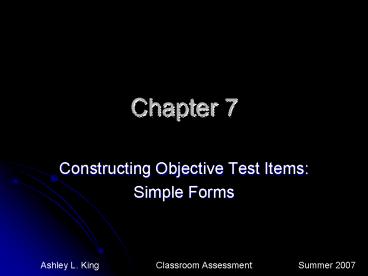Constructing Objective Test Items: - PowerPoint PPT Presentation
1 / 21
Title:
Constructing Objective Test Items:
Description:
... or wrong, correct or incorrect, yes or no, fact or opinion, agree or disagree. ... 6. If opinion is used, attribute it to some source, unless the ability to ... – PowerPoint PPT presentation
Number of Views:753
Avg rating:3.0/5.0
Title: Constructing Objective Test Items:
1
Chapter 7
- Constructing Objective Test Items
- Simple Forms
Ashley L. King Classroom Assessment Summer
2007
2
- Each type of test item has its own unique
- characteristics, uses, advantages,
- limitations, and rules for construction. The
- characteristics that are considered for
- objective test forms that typically measure
- relatively simple learning outcomes are the
short - answer item, the true-false item, and the
matching - exercise.
3
Short Answer Items
- Short answer and the completion item are both
supply type test items. - Can be answered by a word, phrase, number, or
symbol.
4
Uses of the Short-Answer Item
- Is suitable for measuring a variety of relatively
simple learning outcomes. - Some of the common uses are knowledge of
terminology, knowledge of specific facts,
knowledge of principle, knowledge of
method/procedure,and simple interpretations of
data.
5
Examples
- Knowledge of Terminology
- Lines on a weather map that join points of the
same barometric pressure are called______.
(isobars)
6
- Knowledge of Specific Facts
- A member of the United States Senate is elected
to a term of ________ years. - ( 6 )
7
- Knowledge of Principles
- If the temperature of a gas is held constant
while the pressure is applied to it is increased,
what will happen to its volume? - ( it will increase)
8
Knowledge of Method or Procedure
- What device is used to detect whether an electric
charge is positive or negative? - ( electroscope)
9
Simple Interpretations of Data
- How many syllables are there in the word
Argentina? (4) - In the number 612, what value does the 6
represent ? (600)
10
- More complex interpretations can be made when the
short-answer item is used to measure the ability
to interpret diagrams, charts, graphs, and
pictorial data.
11
Advantages and Limitations
- Reduces the possibility that students will guess
- One of the easiest test items to construct
?Unsuitablilty for measuring complex learning
outcomes. ? The difficulty in scoring
12
Construction suggestion for short-answer items
- Word the item so that the required answer is both
brief and specific. - Do not take statements directly from textbooks to
use as a basis for short-answer items. - A direct question is generally more desirable
than an incomplete statement. - If the answer is to be expressed in numerical
units, indicate the type of answer wanted. - Blanks for answers should be equal in length and
in a column to the right of the question. - When completion items are used, do not include
too many blanks.
13
True-False or Alternative-Response Items
- Consists of a declarative statement that the
student is asked to mark true or false, right or
wrong, correct or incorrect, yes or no, fact or
opinion, agree or disagree. - Only two possible answers
14
Uses of True-False Items
- The most common is to measure the ability to
identify the correctness of statements of facts,
definitions of terms, statements of principles,
and the like.
15
Advantages Limitations
- T/F items are very efficient.
- A wide sampling of course material can be
obtained.
- T/F items are not especially useful beyond the
knowledge area. - Susceptible to guessing.
16
Suggestions for Constructing T/F Items
- 1. Avoid broad general statements if they are to
be judged true or false. - 2. Avoid trivial statements.
- 3. Avoid the use of negative statements,
especially double negatives. - 4. Avoid long, complex sentences.
- 5. Avoid including two ideas in one statement,
unless cause-and-effect relationships are being
measured. - 6. If opinion is used, attribute it to some
source, unless the ability to identify opinion is
being measured.
17
Constructing T/F Items (Continued)
- 7. True statements and false statements should be
approximately equal in length. - 8. The number of true statements and false
statements should be approximately equal.
18
Matching Exercises
- Consist of two parallel columns with each word,
number, or symbol in one column being matched to
a word, sentence, or phrase in the other column.
19
Uses of Matching Exercises
- The typical matching exercise is limited to
measuring factual information based on simple
associations. - Has also been used with pictorial materials in
relating pictures and words to identify positions
on maps, charts, and diagrams.
20
Advantages Limitations of Matching Exercises
- The compact form, which makes it possible to
measuring a large amount - The ease of construction
- The matching exercise is restricted to the
measurement of factual information based on rote
learning . - There is difficulty finding homogeneous material
that is significant from the viewpoint of
objectives and learning outcomes.
21
Constructing Matching Exercises
- Use only homogeneous material in a single
exercise. - Include an unequal number of responses and
premises and instruct the student that responses
may be used once, more than once, or not at all. - Keep the list of items to be matched brief and
place the shorter responses on the right. - Arrange the list of responses in logical order,
place words in alphabetical order, and numbers in
sequence. - Indicate in the directions the basis for matching
the responses and premises. - Place all the items for one matching exercise on
one page.































